HET Hex Burst Studies - HBT Users Manual
Reducing Hexburst Data Sets
Last Updated: Sept 2008
HET Hex Burst Studies - HBT Users Manual
The HET hexburst procedure provides us with a method of identifying
problem mirrors in the array. The HEFI camera
is used to image the stacked array at best focus. Offsets
are then sent to the array that shift each mirror by some amount. The
resulting image obtained with the HEFI camera is then a series of
point sources distributed in a pattern that mimics the shape of
the HET mirror array. Each source in this HEFI picture represents
the image formed by an individual mirror. An example of such an image
is shown below in Figure 1. By identifying the
mirror producing each image, and by measuring certain properties
of each image, we can produce a useful record of mirror properties.
This is the job of the HBT code. A record of image properties
kept over time can be used by Jerry Martin and the rest of the day crew
to identify mirrors that need cleaning/aluminizing, mirrors that
have large focus offsets relative to the array as a whole, or
mirrors that produce distorted images due possibly to support
problems.
Since a lot of things changed over the course of developing HBT, the
present procedures for reducing hexburst data are a little convoluted.
Hopefully, this manual will direct us along the path towards a streamlined
analysis approach. Initially, we simply took a series of HEFI images
at different focus settings. The job of HBT was to allow the reducer
to easily identify the mirrors in each HEFI image (i.e. each
focus value), measure image parameters for each mirror, identify
the best focus setting for each mirror, and finally, summarize
all of the results in a web document. Later, we began taking images
with the HEFI lamp set on a high and low setting.
Moreover, we took multiple sets of images at each focus. To handle
this change, a pre-reduction code was developed called HBTPREP. This
routine handles the registration of images in each focus/lamp group.
In reality, it sets up the input script needed to perform this
registration and stacking procedure inside IRAF. After we have stacked
the hexburst images with HBTPREP and IRAF, we run HBT.
For this manual, I will often show the prompts displayed by
HBT or HBTPREP. To denote the user-supplied responses, I
will highlight them in RED.
Notes on taking hexburst images.
VERY IMPORTANT NOTE: As of mid 2006, the HEFI camera no longer writes
Tracker position data to the image header. In such a case the fullpath
image name is parsed to determine the tracker position. It is now critical
that the image naming conventions specified below are followed!!!!
Below I list a few points on name conventions for hexburst
image files. The RA can run a script that renames all
images afetr the the TO completes each set.
Name bias frames:
bst_bias0001.fits
bst_bias0002.fits
bst_bias0003.fits
etc...
Typical hex burst image name:
tr_f=-200_lo_05.fits
1 2 3 4
1: Inidcates if image is Tracker Right (=r) or Tracker Left (=l)
2: The relative focus value, with sign included. Please preceed
the integer focus value with "f=" in the file name.
3: Indicates whether lamp setting is lo or hi. This is now not needed
since we ONLY use lo settings. To avoid software changes and keep
a historically smooth archive we include this part of the name now.
4: A running image name (automatically assigned when running HEFI
camera).
OTHER NOTES:
A) If you have taken a focus=0 image (and used "f=0" in the
image names), and then return to do another focus=0 image,
do not use "f=0" again! This will just over-write the first
set. Use "f=+10", as this small offset will make no difference
in the analysis.
Finally, the easiest way to get the image names set properly is
to have the RA run a script to perform the renaming after each
set of hefi images at a focus position have been collected by the
TO. Here is a typical renaming script:
#
mv h0001.fits tr_f=1890_lo_01.fits
mv h0002.fits tr_f=1890_lo_02.fits
mv h0003.fits tr_f=1890_lo_03.fits
mv h0004.fits tr_f=1890_lo_04.fits
mv h0005.fits tr_f=1890_lo_05.fits
mv h0006.fits tr_f=1890_lo_06.fits
mv h0007.fits tr_f=1890_lo_07.fits
mv h0008.fits tr_f=1890_lo_08.fits
mv h0009.fits tr_f=1890_lo_09.fits
mv h0010.fits tr_f=1890_lo_10.fits
mv h0011.fits tr_f=1890_lo_11.fits
mv h0012.fits tr_f=1890_lo_12.fits
mv h0013.fits tr_f=1890_lo_13.fits
mv h0014.fits tr_f=1890_lo_14.fits
mv h0015.fits tr_f=1890_lo_15.fits
A Brief Overview of the Current Process
A major overhaul of the procedures used in reducing hexburst
data was performed in Spring 2006. Some of these new steps
are not yet described in this web document. I provide a terse
outline of the current process below.
Codes reside at:
/home/banzai/sco/projects/het_sco/src/sco_het_code/hbtcodes
hbt/ hbt_combine/ hbtfinal/ hbtprep/ hbtweb/
Also, on mcs:
/home/mcs/sco/projects/het_sco/src/sco_het_code/hbtcodes
hbt/ hbt_combine/ hbtfinal/ hbtprep/ hbtweb/ README.hbt refoc/
A rough outline for using hbt codes:
1) Use hbt to gather info on what dataset are available.
Pull over desired data sets for reduction.
2) Use iraf to bias correct HEFI image.
3) Run hbtprep to prepare iraf scripts for stacking image.
Use iraf to make the stacks. Use renaming scripts made by
hbtprep to rename the stacked image.
4) Run HBT to identify the mirrors at each focus position.
NOTE:
Here is where all of the big changes of Spring 2006 have a
big effect. I used to do the full analysis in HBT (i.e. fitting
focus curves, etc). HBT made (and still makes!) web pages
summarizing the analysis. I would reduce tracker left,right
images sets separately. The code called hbt_combine was used
to combine such left,right sets and compare results. Basically
just produce a few gif plots.
====> Now I use hbt just through the mirror identification
step.
5) The hbtfinal code now stacks the inidividual mirror images
at each focus set. This is done using file made by the hbtprep
and hbt runs. Refined image parameters are computed, and the
focus curve fitting is done in hbtfinal. The plots and registered
(fits) stamps, as well as gif files of "best focus" images are
archived by hbtfinal.
6) The hbtweb code (still being developed as of July 2007) fully
archives the run. It presently produces ASCII data tables for
mirrors analyzed in the tracker left,right analyses. It will
soon produce a set of summary web pages comparable to that made
with hbt alone, but of course this new analysis is based on
more precisely stacked image sets.
Running HBT-related Codes on Solaris Monitors
The HBT-related programs often rely on a fast graphics capability.
This is not possible on the Solaris machines (mcs and ion) available
in the HET control room. The solution is to run the code on one
of our fast linux boxes using one of the availble Solaris
monitors. Ordinarily, the linux machine will be beta. Here is
how to do it if you are working from ion:
On ion:
xhost +beta
On beta (after you have ssh'd in):
setenv DISPLAY ion:0.0
Initial Setup Steps
Running any of the HBT-related software packages requires some supporting
files that, if present, make operation more streamlined. You need not
worry about them here. I have prepared a script that will build these
files in the directory you working in. Just type on your command line:
hbt_ready_linux On a linux machine
hbt_ready_solaris On a Solaris machine
After running this, the necessary files will be present in your current
working directory.
Running HBT to Prepare for the Reduction
Upon running HTB, you will be asked if you wish to
jump directly to the HBT-related tasks. By responding
positiveley you will be shown a list of tasks. With task
2 you can summarize all of the available hexburst data
on disk, and with task 3 you can set up a reduction of
one of those directories.
sco@ion:T> HBT
Jump directly to HBT-related tasks? (Y/N): Y
====================================================
HBT-related tasks:
1) Read and manipulate tip files
2) Find hexburst data sets
3) Summarize and prepare a hexburst for reduction
4) Build a script to reconstruct a web page
99) Leave this section of HBT
Enter desired task code (99): 2
Are you running on new mcs? (Y/N): Y
20050216
20050217
20050307
20050319
20050404
20050616
20050617
20050701
20050715
20050827
20051011
20051012
======================================================
See the local file called "hexburst_data.list" for a
summary of all hexburst data sest available now.
======================================================
After running task 2, you can view the local file called
hexburst_data.list to see what data are available.
You can quickly determine how many images are available
in a data set (N_images), how many of those images are
compressed (N_compressed), and how many HEFI bias frames
are avalible for that set (N_bias). An example of such a
file is shown below.
Directory N_images N_compressed N_bias
20050216 160 160 0
20051012 180 180 0
20051022 190 195 5
20051118 603 623 20
20051124 660 680 20
20051225 660 680 20
20051231 570 590 20
20060120 480 500 20
20060131 676 696 20
Next, you can run task 3 and get a more detailed summary
of the available hexburst data. Here, a file called
hexprep.out is created. Here is an example of such a
file:
Ntot = total number of hexburst images
N_l = number of tracker_left images
N_r = number of tracker_right images
N_lo = number of low lamp images
N_hi = number of high lamp images
Fmin = minimum focus value
Fmax = maximum focus value
Note: C indicates the image data are compressed
Directory Ntot N_l N_r N_lo N_hi Fmin Fmax
20050216 160 80 80 80 80 -600 600 C
20050217 190 80 110 100 90 -800 1000 C
20050307 200 100 100 100 100 0 2400 C
20050319 200 100 100 100 100 0 2400 C
20050404 170 80 90 85 85 -2300 0 C
20050423 100 0 100 50 50 -600 1000 C
20050502 100 0 100 50 50 -600 1000 C
20050616 200 95 105 105 95 -1000 600 C
20050617 220 110 110 110 110 -1200 800 C
20050701 205 100 105 100 100 -600 1000 C
Note that option 3 can actually perform two tasks. In the first
case, you can produce a table like that above (job choice 1).
By selecting job choise 2, you can set up for reducing a specific
hexburst set. You will be queried for the name of the hexburst
directory (i.e. 20050502). A script is created (called "MAKE_1.SCRIPT")
that can be used to pull over the neccassary images for a reduction
and store them in a convenient directory tree structure.
Note that at this time, it is very important that you use one of
the hexburst data summary files (above) to determine if the data
files are compressed or not. If the files are compressed, then
you should use the unix uncompress command in the guider directory
in question. This must be done prior to completing a run of job
choice 2 in option 3, otherwise the images names will not be
interpretted correctly.
Here is an example of how you might do this:
> cd /data1/mcs/guider/20050502
> uncompress *.Z
A SPECIAL NOTE: If the hexburst images
were named properly, then the option 3 step explained above will
automatically perform steps need for HBTPREP. The tracker-left
and tracker-right images will be written to separate reduction
directories (called Tl_lo and Tr_lo respectively). These directories
will contain the hbtprep.in files that you will need to run
HBTPREP. Also, the bias frames will be deposited in a local
directory called zero.
Running HBTPREP
Our first job (after transferring the hexburst data set to our
reduction machine) is to subtract the HEFI bias pattern from
each HEFI image, and then combine the images sets taken at each
focus setting and lamp setting. The following procedure describes
what is being done as of July 2007.
If the bias frames are available for your hexburst set, then
the first data reduction task will be the construction of
a mean bias frame, and the subtraction of that mean frame
from all of your hexburst images. Some of these steps will
be done with IRAF. Normally, we will maintain a directory called
iraf that will be dedicated to hexburst reductions. You will normally
just go to the working hexburst iraf directory and type "cl" to start up iraf.
Step 0: Confirm bias images are present.
In many of the early hexburst data sets no bias frame images
were collected. These images should have the name
format bst_bias-####.fits.
Step 1: Bias subtraction
I am using the current method to perform bias subtraction prior to any
treatment by HBTPREP. This way the images are cleaned up prior to the
SExtractor runs. The zero.fits image is created with iraf imcombine
using at least 20 HEFI bias images. A simple way to do this (in the zero
directory) is:
cl> files bst* >list
cl> imcombine @list zero
The bias subtraction is done with iraf in the image directory
and OVERWRITES the original images:
cl> files *.fits >list
**** might want to edit list to be sure all is well ****
cl> imarith @list - zero @list
For a set ~200 images this takes about 1.5min on banzai. An example
of how important this step can be is shown in Figure 0 below.
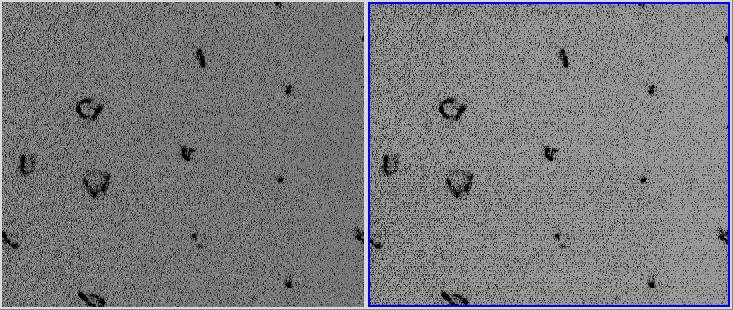 |
Figure 0: A HEFI image treated with a bias subtraction (left)
and without (right). The uncorrected image clearly contains
a larger level of systematic noise.
|
Step 2: Run HBTPREP
To run the HBTPREP tool, I must prepare a basic input file (called
hbtprep.in)
# data
final_image_name
0
5
tl_f=00_h-0001.fits
tl_f=00_h-0002.fits
....
The first number value after data is the focus value. The second
value after data is the number of images in the set. This structure
is repeated enough to cover all images in the hexburst set.
A note about output names:
To make image transfer easier, I name the stacked images with the
follwing syntax:
Tr_f-1200_h
where r denotes tracker-right, and h denotes high lamp setting.
The focus is encoded in the usual way. Canging the "t" in the
original names to a "T" in the stacked-image names makes downstream
data management easier.
To run the HBTPREP on your Sun or linux machine:
# HBTPREP
After the HBTPREP code is run, then the HBTPREP-built script named
combine.cl is run within iraf:
cl> cl < combine.cl
This will produce the shifted HEFI images and the final composites for
each focus/tracker_state/lamp_state image set.
A SPECIAL NOTE:
As of March 2006 I have made a number of tests with large (N=15)
sets of HEFI images in iraf's imcombine package. Ideally, we would
make an average stack (by setting the combine argument to "average").
However, occasionally we obtain corrupt HEFI image files that are
read out improperly. An averaging approach will suffer substantially
from such bad images. If you use the image viewing option in HBTPREP
to manually reject such images, then an average can be used. I suggest
that if the completely automated approach is used (no gui reviews) then
before you run the combine.cl script, make sure that the value of
combine is set to "median". The median stack will be more robust
against the occurrence of bad HEFI images.
After combine.cl is run in iraf, the composite images are
named comp01.fits, comp02.fits, etc. The local script (again
built by HBTPREP) will rename the images (based on the values
in hbtprep.in):
[sco@banzai 20050404]$ chmod 777 RENAME.scrpt
[sco@banzai 20050404]$ RENAME.scrpt
directories where 4 separate HBT runs will be performed.
At this point, if you are working on one of the Solaris machines,
you might want to delete the original (unstacked) HEFI images. I
usually create a subdirectory called store1, and move the stacked
images (T*.fits) there. Next, you can quickly delete all files in
the upper work directory. This saves valuable disk space on mcs
and ion, machines that can be used to quickly reacquire the original
HEFI images should you need them again.
Running HBT to Reduce the Images
The first job to do is to construct an input file (named hbt.in) that
will tell HBT which images it will be processing. In addition, this
file will assign a focus value to each image. An example of
hbt.in is shown below:
Tl_f-1500_l.fits 1500
Tl_f-1100_l.fits 1100
Tl_f-1300_l.fits 1300
Tl_f-1700_l.fits 1700
Tl_f-1900_l.fits 1900
Tl_f-2100_l.fits 2100
Tl_f-2300_l.fits 2300
Tl_f-900_l.fits 900
The format of hbt.in is pretty simple. Each line in the file corresponds
to a different image. On each line (in free format) we list the image
name and the focus seeting used to generate that image. The focus values
must be entered as integer values (i.e. use 2300 instead of 2300.0). You
can generate this file using any kind of editor (like vi or emacs).
A useful thing to know prior to running HBT is that sometimes
you will be asked if you want to skip a step or skip to another
section of the code. These are shortcut
steps that can be performed only if previous HBT runs on your data
have been made. In general your answer will be
N . Actually, you can also just enter
a return and HBT will know not to make the skip.
[sco@banzai TL_l_jun16_raw]$ HBT
Assumed platform = del
Number of hex-burst images = 8
Skip opening a ds9 window? (Y/N): N
Jump directly to combine and analysis? (Y/N): N
Jump directly to HBT-related tasks? (Y/N): N
Enter desired thresh,irad,ism (3.0,10,2): 5 10 2
At this stage, the program is preparing to detect the mirror sources in
your firts HEFI image. You must supply the detection parameters for
this. The last 3 numbers above (5 10 2) are values that I have found
to be good values for our hexburst images thus far. After you enter these
values, the sources are located and an image much like what you see in
Figure 1 is displayed. The only difference is that you must interactively
draw the blu line in the ds9 gui that locates the central column of
the HET mirror array. The line marker is already set be a "BLUE LINE".
You simply click on the top mirror position and drag to the bottom
mirror position. Note that before doing this, it is often convenient
to use the "Zoom to Fit Frame" option in the Zoom menu, so that the
entire HEFI image is visible.
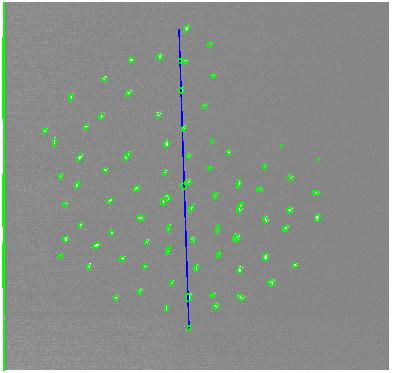 |
Figure 1: A typical HEFI image of the HET mosaic obtained during a
hexburst. The individual mirror images (the white spots) have
been located with a source-finding code (SExtractor) and circled
with green ellipse markers. In order to begin the process of identifying
mirrors, we must give HBT an idea of the location and size
of the central column of mirrors. We set this location graphically in
a ds9 window (opened by the code) with a blue line marker. We place
the top part of the line segment on the top mirror (6:11) and the
bottom part of the line segment on the bottom mirror (6:1).
|
Once the central column of mirrors has been located, HBT will have
an estimate of the location, orientation and scale size of the HET
mirror array on the HEFI image. At this point, you may wish to
identify mirrors that are clear problem cases. You can do this
using different ds9 marker symbols, as is outlined in the HBT command
window at this point in running the code. An example of this
is shown in Figure 2.
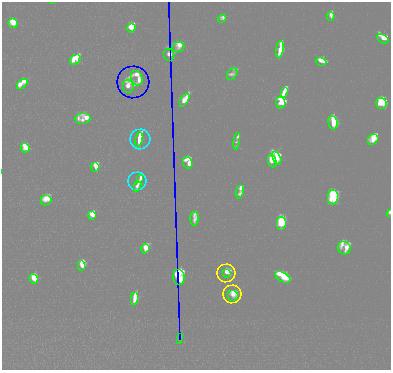 |
Figure 2: An example of identifying special mirror cases with a
ds9 marker. This step is optional now, but may someday a very
important part of the HBT reduction. As the HBT command window
will tell you, we use
(1) YELLOW circles to locate images from different
mirrors that are very close together.
(2) BLUE circles to identify a doughnut mirror
(3) CYAN circles to identify an astigmatic mirror.
After you hit a return in your ds9 window, HBT will paint
up the assumed positions for the HET mirrors using cyan
hexagons.
|
When you hit a return in the HBT command window, whether
or not you have marked problem mirrors, the program will next
paint up the HEFI image, along with a set of cyan hexagons that
denote where each HET mirror is presently thought to be located.
An example of this is shown in Figure3. Note also that you see
sets of red circles also drawn. These red circles indicate the
actual locations of the mirror images that HBT has adopted
for each source. Close inspection of Figure 3 reveals that
a number of the "sources" in the image are actually composed
of several green ellipse markers (i.e. multiple detections
were obtained in the source detection phase). The red circles
indicate how sets of multiple detections for a single source
are "glued" together to represent one mirror image. The next
thing you should notice in Figure 3 is that many of the mirror
positions (the red circle positions) do not sit in the middle
of their respective cyan hexagons. In other words, HBT does
not yet have a good value for where these mirror images are really
located. Hence, we must communicate a revised position, or
offset position, for those mirrors that are not located well.
The yellow line marker that you see in Figure 3 accomplish
this. For each badly located mirror, you just click in the
approximate center of the appropriate cyan hexagon, and then
drag to the appropriate mirror (red circle) image. After this
you will see a yellow line indicating the offset you have
just set.
Presently, I prefer to mark a yellow offset line for nearly
every mirror source in this firt HEFI image. HBT will use these
offsets in all subsequent images as a first guess to where each
image should be. Since we are only change the focus position
in each image, and no actual mirror offsets (i.e. actuator
adjustements) have been applied, then these relative mirror
offset positions should sclae with the size and location of the
HET array on each HEFI image.
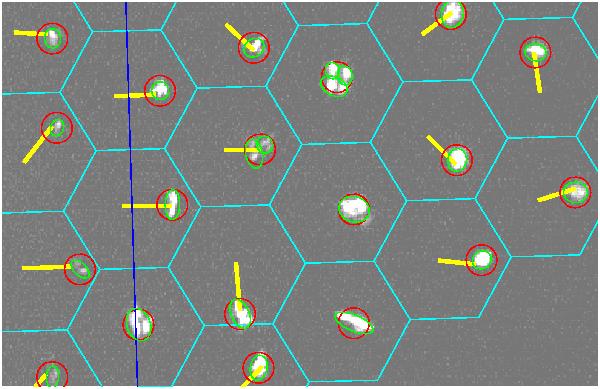 |
Figure 3: A close up view of the HET mirror positions currently
assumed by HBT. The assumed mirror positions are painted up as cyan
hexagons. Use the YELLOW line marker to correct the positions
of badly positioned mirrors. Attach the initial line endpoint to
the approximate center of the correct cyan hexagon, and connect
the final line endpoint to the red-circled image for the mirror
you wish to identify.
|
After you hit a return in the HBT command window, a new image like
that in Figure 4 is drawn. This shows which mirror sources you have
drawn offsets for.
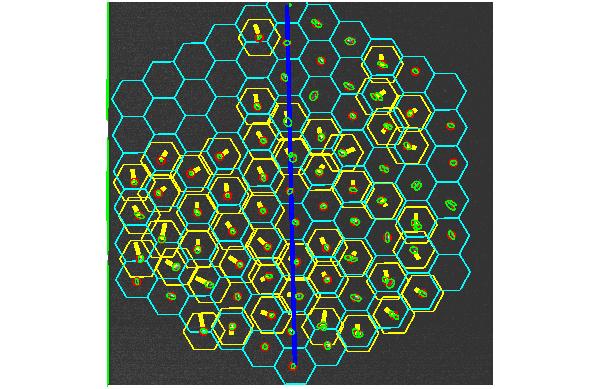 |
Figure 4: After setting the yellow line segments, and hitting a return
in the HBT command window, you will a graphic such as this. For every
mirrror that you assigned an offset, that new position will be indicated
by a yellow hexagon.
|
After you hit a return in the HBT command window, a new image like
that in Figure 5 is drawn. This shows the current state of mirror
offsets you have adopted for this HEFI image. You can apply more
yellow line segments at this stage, but by the time you get here
(for each HEFI image) you are done.
 |
Figure 5: After hitting a second return in the HBT command window, you
will a graphic such as this. It is basicaly a less complicated version
of Figure 4. All mirrors with special offset positions are painted
with magenta hexagons, and those with no offset are painted as the
usual cyan hexagon. At this point, you may once again use the
yellow line marker to assign offsets. You can do this for either
type of hexagon (cyan or magenta). You enter a return in the HBT command
window when you are satisfied with your updated positions (if you
entered any).
|
At this stage, the process is repeated for the next (and all subsequent)
images that you have listed in the hbt.in file. You'll once again
have to mark the position and size of the central mirror column.
However, after the central column is marked in these subsequent
images, you will see that the mirror positions are painted onto
the screen with the special offsets set in your first image, but
appropriately scaled to match the scale size of the current HEFI
image. If all is well, you should not have to use any yellow line
segments to re-position mirrors.
A special case of HEFI image
In the more extreme focus positions, the array of mirror images will
overflow the field of view of the HEFI image. Unfortunately, this means
that we may be unable to locate mirrors 6:1 and 6:11 (the top and
bottom mirrors in the HET array). The solution is it locate other
mirrors in the central column. The logical choices are 6:2 and 6:10.
We do this by changing the line marker color from blue to red when
we are asked to mark the central column. After this is done, and
the program recognizes a red line has been used, you will be queried for
the actual mirror numbers you have used. These will almot always
be 10 for the top and 2 for the bottom, but you have the capabilitu
of using any mirrors in the central column.
Finishing the Job: The Old Pre-Spring06 Method
Currently, much of the analysis described in this section is
performed by stand-alone downstream codes. For completeness, and
because we can still use HBT alone for the anlysis, I am retaining
this description of the old approach in the manual.
At this stage in the HBT execution, we have located our mirrors, and
computed image parameters for each mirror in each focus position. We'll
now determine which HEFI image provides the best focus image for
each identified mirror.
Skip the combine and webpage steps? (Y/N): N
Graphically review focus curve fits? (Y/N): Y
After you answer the last question above, a fairly long process
will occur: a small image around each mirror, in each HEFI image,
is extracted and archived for later use. These "postage stamp"
images will be used for later photometric parameter determination
and web-based image graphicster on.
This last query above concerns how we will select the best focus
position for each mirror. If you answer Y
(which is what we'll generally alway do), then HBT will beging
to exhibit the focus curve for each mirror. A PGPLOT window will
appear that shows, for each mirror, a plot of R50 (Y axis) versus
focus position (X axis). The parameter R50 is the radius of a
circle (in arcsecond units) that encloses half the total light
in a mirror image. Hence, at best focus, this value should be at
a minimum. In reality, there are a host of problems that can
occur in computing R50 (and everything else!) that can occasionaly
produce a spuriosly low value of R50. Hence, we will use the
focus plots to eliminate such cases. We can use the stamp images
painted in the ds9 window to help judge proble cases. The image
associated with each point in our focus plot is shown in the ds9
window. The focus value is printed in read letters in the bottom
left-hand corner of each stamp.
 |
Figure 6: A focus plot used in HBT to determine best focus position.
Obviously discrepant data points can be rejected with the "Z" key, and
are painted with a yellow box. If desired, a parabolic fit can be computed
with the unrejected points with the "P" key. The resultant parabola (shown
in green above) is used to estimate the best focus position for this
mirror.
|
 |
Figure 7: The postage images associated with each point in the focus
plot of Figure 6.
|
After the last focus plot is inspected (usually somewhere close to
segment #91), the HBT program will collect all best focus positions
and and construct a web document that summarizes the results of
the analysis. This document resides in a local subdirectory named
"web".
Running HBTFINAL
HBTFINAL is used to stack individual mirror images for each focus
set. The stacked stamp images are stored in the local directory
(created by HBTFINAL) called stamps_1. When the stamps are cut,
they are then photometered. The results are stored in the
HBTFINAL-created directory called mirror_data. After the stamps
are photometered, the user interactively fits focus curves for
each mirror set. Currently, the final results of this analysis
are written to a file called "list_1.out".
Running HBTWEB
HBTWEB is run in the top level directory of you hexburst reduction
directory (i.e in ~sco/hex_real/20070617). It creates a local web
directory with a set of html documents that summarize the reduction
and allow the user to quickly see the summary plots for each
mirror in the analysis. The name of the directory is web_DATE, where
DATE is the name of the reduction directory (i.e. 20070617). These
are stand-alone directory trees that can be easily transfered to
the hexburst data home page.
Running REFOC
In some cases, usually due to user error, the hexburst focus
curve for a mirror may have been fitted incorrectly. You can
use the REFOC code to refit single mirrors. This code is run
in the top-level redcution directory (just like HBTWEB). You
must run it once for each mirror to be corrected. In esseance,
this code reconstructs the plots focus_r50.gif and profile.gif
in the mirror_data/hex** subdirectroies. It also reconstructs
the files recording information about the selected best-focus
image.
It is important to remeber that after you use REFOC, you must
re-run the HBTWEB tool in order for the changes to be made in
the summary web page.
Back to Hex Burst Page







